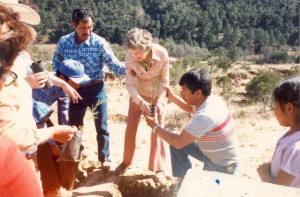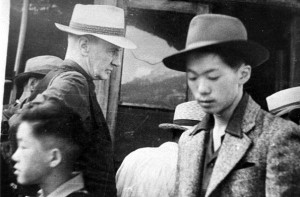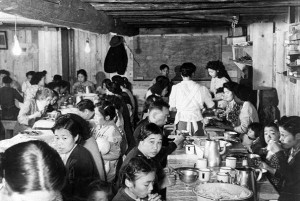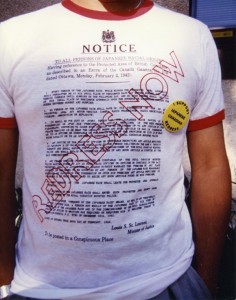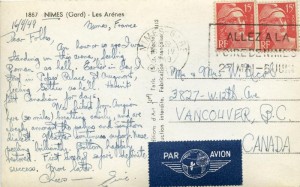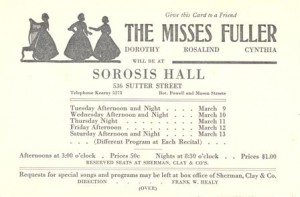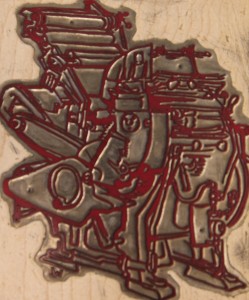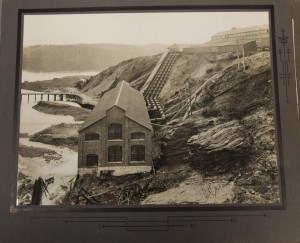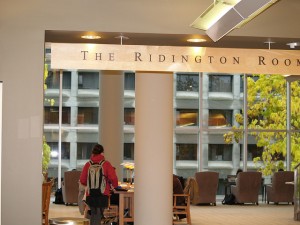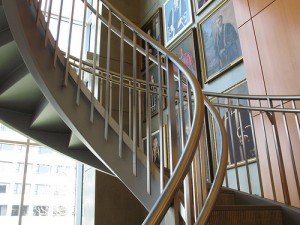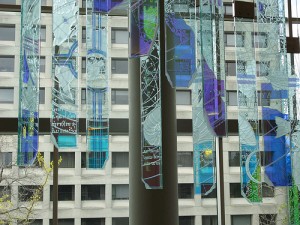Featured place: Kootenay River
Posted on April 5, 2011 @9:00 am by kalsbeek
The Kootenay River Room, a large, bright and airy group study room (room 422) on the 4th floor of the Barber Centre, is named after the Kootenay River, one of the tributaries of the Columbia River. It is a major river that runs through southeastern British Columbia, Canada and the northern part of Montana and Idaho. Throughout the history of British Columbia, many people from various backgrounds have lived and traveled along its banks.
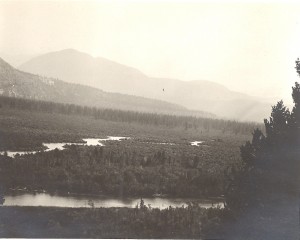
The very source of the Columbia River, looking south across Canal Flat toward the Kootenay river, ID # BC-146
The people of the Ktunaxa (Kootenai) nation have lived, fished and hunted along the river for thousands of years.
In the early 19th century, the first European explorer to visit the area, David Thompson, explored and surveyed the Kootenay’s banks, calling it “McGillivray’s River” on his 1814 map (the original map is in the Archives of Ontario and is part of F443, the David Thompson fonds ). Rare Books and Special Collections has a reproduction of Thompson’s 1814 map, published by the Champlain Society in 1916 : Map of the north-west territory of the province of Canada.
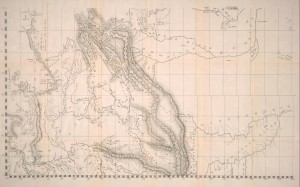
Image credit: Champlain Society Digital Collections: http://link.library.utoronto.ca/champlain/search.cfm?lang=eng
In the late 19th century, the Doukhobors, a “Spiritual Christianity” sect that originated in Russia in the late 16th-17th century and rejects organized government and the church, left Russia and travelled to Canada. Various groups settled in Manitoba, Saskatchewan and British Columbia. In 1908, the group that settled in British Columbia, called the Community Doukhobors, purchased 2,700 acres of land along the Kootenay River. Their leader, Peter Verigan, called the settlement “Brilliant,” after the sparkling waters of the river.
In Rare Books and Special Collections, there is a large body of archival material related to the Doukhobors. You may be interested in consulting the Doukhobor research collection , the Peter Faminow fonds and the Jim Hamm research collection.
In 2010, the Irving K Barber British Columbia History Digitization Program funded a digitization project by the Touchstones Nelson: Museum of Art and History, Changes Upstream: Along the Kootenay River North of the 49th Parallel Before and After the Libby Dam, 1969-72. Visit this digital exhibition to view images of the homes, lifestyles and lands of communities along the Kootenay River during the summers of 1969-72.
No CommentsPosted in Collections, Uncategorized | Tagged with Barber
Updated archives: Mildred Fahrni fonds
Posted on March 25, 2011 @8:35 am by sromkey
We have recently updated the archives of Mildred Fahrni, a social activist from B.C. who was active in a number of human, woman’s and children’s rights organizations, including the YMCA, the Women’s International League for Peace and Freedom, and a school for homeless boys in India. An active speaker and lecturer, she won the Vancouver Peace Award in 1991 before she passed away in 1992.
The archives include files on various issues and organizations, including Fahrni’s own notes and other collected documents, extensive photographs of her travels through Russia, India, Japan, Central and South America and the Middle East, and recordings of Fahrni interviewing and being interviewed by others on various human rights and social issues. This collection is one of many that show the impact of British Columbians worldwide.
No CommentsPosted in Collections, Uncategorized | Tagged with
Featured place: Slocan
Posted on March 23, 2011 @8:15 am by sromkey
This week’s featured place name and Irving K. Barber Centre room is Slocan. Slocan can refer to a number of geographic features- Slocan Valley, River, Lake, or City. This region is in the West Kootenay area of British Columbia.
We are using Slocan to highlight our Japanese-Canadian resources, because the village of Slocan (commonly known as Slocan City) was one of the sites of the Japanese Canadian internment camps during the Second World War.
The photographs below are from the Japanese Canadian Historical Photograph Collection, which is digitized and available freely online. There are a number of photographs of the Slocan internment camp in the collection, including photographs of Japanese Canadians arriving at the camp, as in the first photo, and of daily life in the camp, as in the second photo, taken in the dining hall.
Textual records related to Japanese Canadians in Slocan can be found in the Japanese Canadian Research Collection, in the Yamaga Yasutaro fonds, and also in the Jack Duggan fonds. Jack Duggan was a supervisor for the R.C.M.P. at the Slocan camp. Author Joy Kogawa (whose archives are located in Rare Books and Special Collections) and environmentalist David Suzuki (whose archives are located in University Archives) were both sent as children to the Slocan camp in 1942.
In the Barber Centre, the Slocan room is part of the School of Library, Archival and Information Studies (SLAIS). Specifically, this room is a study area frequented by SLAIS’s doctoral students. You can read about the doctoral students and their research interests here.
No CommentsPosted in Collections, Uncategorized | Tagged with Barber
A year of writers’ archives
Posted on March 18, 2011 @1:45 pm by sromkey
Rare Books and Special Collections collects the archives of a number of British Columbian authors, all of whom have made a significant impact on literature in this province. A number of these archival collections have been updated over the past year or so (click on the name of each author to read the finding aids for the archives):
Roy Miki is an author, poet, and literary scholar, but is also well known for his advocacy work concerning redress for Japanese Canadians who were sent to internment camps during the Second World War. The addition to his archives includes records related to writing, teaching and editing, but also a significant body of research on Japanese Canadian history and the issue of redress, including photographs, research notes and audio recordings of oral histories and redress committee meetings.
Joy Kogawa is best known as the author of Obasan and Naomi’s Road, read in classrooms across the country. Although she currently resides in Toronto, she grew up in Vancouver before being sent to an internment camp with her family during the Second World War (the Land Conservancy of B.C. is currently preserving her childhood home). The addition to her archives includes records related to several of her novels: Emily Kato, Itsuka, Obasan, The rain ascends, Naomi’s Road, and A garden of anchors. These records include drafts in various stages, correspondence with publishers, and articles and clippings about the novels.
David Watmough is a British expat who has been living in Vancouver since 1962. He writes in a variety of mediums: poems, short stories, novels, plays, monodramas, and sonnets. Watmough has been active in the British Columbia literary scene since his arrival, and is also credited with opening the doors for gay and lesbian writers in B.C., as the first openly gay male writer in the province. The addition to his archives includes drafts of short stories, poems and sonnets- see Box 80 in the finding aid.
Finally, we have recently updated the archives of Eric Nicol, who sadly passed away on February 2 this year. Although Eric Nicol did not describe himself as a humourist, his numerous pieces of humour poked fun at Canadian politics, sports, and life in British Columbia and won him numerous Stephen Leacock awards for humour. The most recent addition to his archives includes publication and financial records, and manuscripts, for his latter books, and a wonderful collection of correspondence he wrote to his parents and friends while traveling in Europe in the 1940’s and 50’s. As his obituary in the Victoria Times Colonist read, “RIP. LOL.”
No CommentsPosted in Collections, Uncategorized | Tagged with
New archives: the Fuller family singers
Posted on March 14, 2011 @9:00 am by sromkey
A modestly sized but interesting collection has been added to Rare Books and Special Collections- the Fuller family fonds contains the records of a family of musicians- Rosalind, Cynthia and Dorothy Fuller were the talent, brother Walter acted as their manager. The Fuller sisters originated from Dorset, England, but these records are from their American tour in the mid to late 1910’s. The Fuller sisters performed English, Irish and Scottish folk songs, in Victorian costume and accompanied by harp. Their travels took them throughout America, but primarily in the Eastern and Midwestern United States. Walter Fuller was based during this time New York, and managed their bookings and other business matters. It appears that the family moved back to England after the end of the First World War.
The collection contains correspondence between Walter and the sisters, as well as business documents such as contracts and receipts. Additionally there are concert programs, reviews, requests from audience members, and printed music broadsides which the family had printed and sold. Photographs show the sisters and Walter, and sketches and drawings show some of their impressions from their travels.
There are few, if any, secondary sources related to the Fuller sisters’ musical contributions, although some mention of their performances can be found in historic publications by searching Google Books for their names. Their brother Walter does have a famous connection though- while in America, he married Crystal Eastman, feminist activist and co-founder of The Liberator magazine and the Women’s International League for Peace and Freedom. Walter’s own feelings on the War are revealed in a 1917 letter to his sister Dorothy:
“As to the question of giving the concert for ourselves or of sharing profits with the Red Cross, I really cannot make up my mind… I am constantly having the idea in my mind, of our giving these concerts for some more innocent sufferers from the war than the soldiers. There is for instance the Blue Cross, which does good things for the horses at the front, and then, or course, there are various funds in aid of children in all the countries.” (From file 1-1).
This collection came to Rare Books and Special Collections as part of the Phillip J. Thomas Popular Song Collection, which consists mostly of sheet music and books about popular forms of song, including ballads, folk music, hymns, work songs, and more.
1 CommentPosted in Collections, Uncategorized | Tagged with
Featured place: Sandspit
Posted on March 7, 2011 @3:21 pm by kalsbeek
In mid-November, our featured place was Moresby Island. It was interesting to learn that there are actually two Islands with the name Moresby in British Columbia.
One of those Islands named Moresby Island is located in the Queen Charlotte archipelago. Our featured place this week is Sandspit, a small community of approximately 400 people, located on the northeastern tip of Moresby Island, near Spit Point. Situated between two beaches– Shingle Bay Beach to the west and Shell Beach to the south-east– Sandspit is the only settlement on Moresby Island.
Located on a long peninsula of sand and gravel, Sandspit has been home to the Haida people for thousands of years. The town today is sustained by logging, transportation (it has the largest airport on Haida Gwaii) and tourism.
In Rare Books and Special Collections, we do not have a lot material on Sandspit. So, to search for archival records related to Sandspit, or other small communities in British Columbia, we recommend that you try searching MemoryBC.ca, a portal where you can access descriptions of archival materials preserved in repositories throughout the province.
If you search for the keyword “Sandspit”, you will retrieve records from the Haida Gwaii Museum at Qay’llnagaay, located on nearby Graham Island.
Room 381, the Sandspit Meeting Room, is named after this important community in British Columbia. Located on the third floor of the Irving K Barber, this meeting room is part of the Gateway Programs: Arts One, Science One, Coordinated Science and Coordinated Arts.
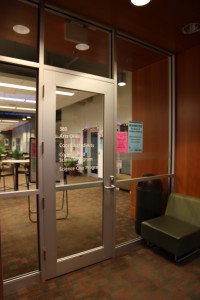
Posted in Collections, Uncategorized | Tagged with Barber
New archives: Heavenly Monkey fonds
Posted on March 4, 2011 @4:42 pm by sromkey
We’re thrilled to announce that Rare Books and Special Collections is now the home of the archives of Heavenly Monkey letterpress and binding studio. We have been long-time collectors of the output of Heavenly Monkey (search the library catalogue) and now you can use the archives to understand these beautiful publications from start to finish.
Heavenly Monkey is the imprint of publisher Rollin Milroy, and grew from his first press called A Lone Press in 1999. Heavenly Monkey is dedicated to the use of techniques and materials traditional to the fine book arts- handmade paper, letterpress printing and fine bindings. Its catalogue is eclectic; according to Milroy, he prints things he think he would appreciate having on his own book shelf. Heavenly Monkey has collaborated with an impressive group of authors, designers bookbinders and publishers, including Robert Reid, Jim Rimmer, Barbara Hodgson and Claudia Cohen.
The archives contain everything you would want to see to understand a Heavenly Monkey book from start to finish, from setting copies, layout schematics, dummies, impressions, printing blocks and plates and correspondence with collaborators. The collection was catalogued by one of our student archivists, who described the process as being “like Christmas-” every little package contained something new and wonderful to explore.
Stay tuned- soon we will have available a copy of Heavenly Monkey’s most recent publication, The WunderCabinet, by Barbara Hodgson and Claudia Cohen. It is a truly remarkable collaboration.
To find out how Heavenly Monkey got its name, you’ll have to come to Rare Books and Special Collections to see the Heavenly Monkey’s 2002 Christmas card- box 2 file 3.
No CommentsPosted in Collections, Uncategorized | Tagged with
Featured place: Granby River
Posted on February 23, 2011 @9:00 am by sromkey
As part of our ongoing series of blog posts featuring place names in B.C. from the room names in the Irving K. Barber Learning Centre, today we will take a look at Granby River. Originally referred to as the North Fork of the Kettle River on early B.C. maps, the Granby River meets the Kettle Riverin Grand Forks B.C. and got its name from the Granby Smelting Company which operated on its banks. The owner of the Granby Smelting Company named the company after his hometown in Quebec (see B.C. Geographical Names). The company also expanded into other parts of the province and built a number of “company towns,” as shown by archival material in the Royal B.C. Museum and Archives, the Nanaimo Community Archives, and the Penticton Museum and Archives.
At Rare Books and Special Collections, we have a photo album showing various aspects of the operation of this company in Anyox, B.C., dating from sometime in 1910’s. The photographs show both external and internal views, showing the placement of the plant on the river, the machinery inside, and in some cases employees.
Note that these photographs are not from Granby River, but rather from the company town of Anyox. The Granby company was so influential that the body of water that this plant was on was also named Granby Bay. This photo album is part of our B.C. Historical Photograph Album Collection. Although the finding aid for this collection is in an older format, the collection is rich with historical views from all of British Columbia.
In the Barber Centre, the Granby River room is a group study room on the 4th floor, facing East Mall. These study rooms are bright and airy, and very popular for group work. They can be booked online.

Group study room in Barber Centre. Photo courtesy of UBC Library (http://www.flickr.com/photos/ubclibrary).
Posted in Collections, Uncategorized | Tagged with Barber
Featured place: Fraser River
Posted on February 9, 2011 @9:49 am by sromkey
In this week’s installment of Rare Books and Special Collection‘s blog series on B.C. place names from the Irving K. Barber Learning Centre, we’ll take a close look at the Fraser River.
The Fraser River is, not surprisingly, named after the explorer Simon Fraser who fully explored the river in 1808. The longest river in British Columbia (over 2,200 km), it originates in the Rocky Mountains and flows into the Straight of Georgia.
Gold was struck in Fraser River around 1858 which is the origin of our featured document. This broadside entitled The Frazer River Thermometer was published in San Fransisco in 1858 and has humorous illustrations of miners leaving their lives and families in California to seek gold in British Columbia, describing the area as the “new El Dorado of the North.” Note the older spelling of “Fraser” with a “z” instead of an “s.” Very few copies of this document are known to exist, but we have one copy on display in the Chung Collection exhibition room, and another which is available upon request in our reading room for closer consultation. Early B.C. history is one of the main focuses of the Chung Collection, along with immigration and settlement, and the Canadian Pacific Railway Company. The exhibition displays highlights from the collection, but the collection is much larger, numbering approximately 25,000 items.
In the Barber Centre, the Fraser River room is part of the facilities of the Centre for Teaching and Learning Technology, on the 2nd floor.
No CommentsPosted in Collections, Uncategorized | Tagged with Barber
Featured room: Ridington Room
Posted on January 26, 2011 @1:54 pm by kalsbeek
This week, we thought that we would post on the Ridington Room, a room in the Barber Centre that is not named after a place in British Columbia.
Rather, the Ridington Room (room 321) is named after an important person in the history of the University of British Columbia Library: John Ridington.
John Ridington was UBC’s first University Librarian. A former journalist and teacher, he started work on the library collection in August 1914 when UBC was in its temporary home at West 10th Avenue and Laurel Street (the Fairview Shacks). By 1916, he had been appointed University Librarian, a position he remained in until his retirement at the age of 72 in April 1940. According to information gathered by the UBC Archives, Ridington was known as a rigid authoritarian and was nicknamed ‘King John’.
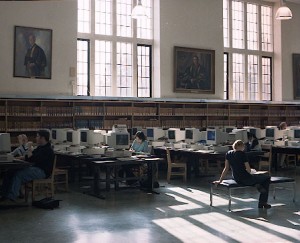
In the former Main Library, there was also a room named after Ridington. Photo courtesy of UBC Archives. UBC Archives photo #76.1/22
The University Archives is responsible for collecting material related to the University and, therefore, holds the papers of John Ridington and his family. If you are interested in learning more about the life of UBC’s first University librarian, take a look at the finding aid (“an aid for finding items in an archival collection”) to the collection that is available on the University Archives website.
The Ridington Room is definitely worth a visit if you haven’t already had the oppportunity to see the space. It is often called the “Harry Potter Room” by students, due to the winding staircase and the portrait-covered walls. A portrait of John Ridington, painted in 1912 by his brother-in-law Malcolm Charleston, hangs in the Ridington Room.
There is also a magnificent art installation by Vancouver artist John Nutter, who was commissioned by Jean Barber to to design a 45-panel glass sculpture that is intended to “flow like the Northern Lights,” and features intricate etchings designed around a series of compasses. Nutter felt the Library, like a compass, should be used “as a tool of discovery.” It is an ideal space for quiet study, but be sure to arrive early because the comfortable chairs fill up quickly!
No CommentsPosted in Collections, Uncategorized | Tagged with

